sensor INFINITI QX50 2021 Workshop Manual
[x] Cancel search | Manufacturer: INFINITI, Model Year: 2021, Model line: QX50, Model: INFINITI QX50 2021Pages: 542, PDF Size: 3.51 MB
Page 311 of 542

The RCTA system uses radar sensorsO1in-
stalled on both sides near the rear bumper to
detect an approaching vehicle.
The radar sensors
O1can detect an ap-
proaching vehicle from up to approximately
66 ft (20 m) away.
LSD2216LSD2920
Starting and driving5-69
Page 313 of 542

RCTA SYSTEM LIMITATIONSWARNING
Listed below are the system limitations for
the RCTA system. Failure to operate the
vehicle in accordance with these system
limitations could result in serious injury or
death. •
Always check surroundings and turn to
check what is behind you before backing
up. The radar sensors detect approach-
ing (moving) vehicles. The radar sensors
cannot detect every object such as:
– Pedestrians, bicycles, motorcycles,
animals or child-operated toy ve-
hicles
– A vehicle that is passing at speeds
greater than approximately 19 mph
(30 km/h)
– A vehicle that is passing at speeds
lower than approximately 5 mph
(8 km/h)
• The radar sensors may not detect ap-
proaching vehicles in certain situations:
– Illustration
OA: When a vehicle
parked next to you obstructs the
beam of the radar sensor.
– Illustration
OB: When the vehicle is
parked in an angled parking space.
– Illustration
OC: When the vehicle is
parked on inclined ground.
– Illustration
OD: When an approaching
vehicle turns into your vehicle's park-
ing lot aisle.
– Illustration
OE: When the angle
formed by your vehicle and ap-
proaching vehicle is small.
LSD3195
Starting and driving5-71
Page 314 of 542
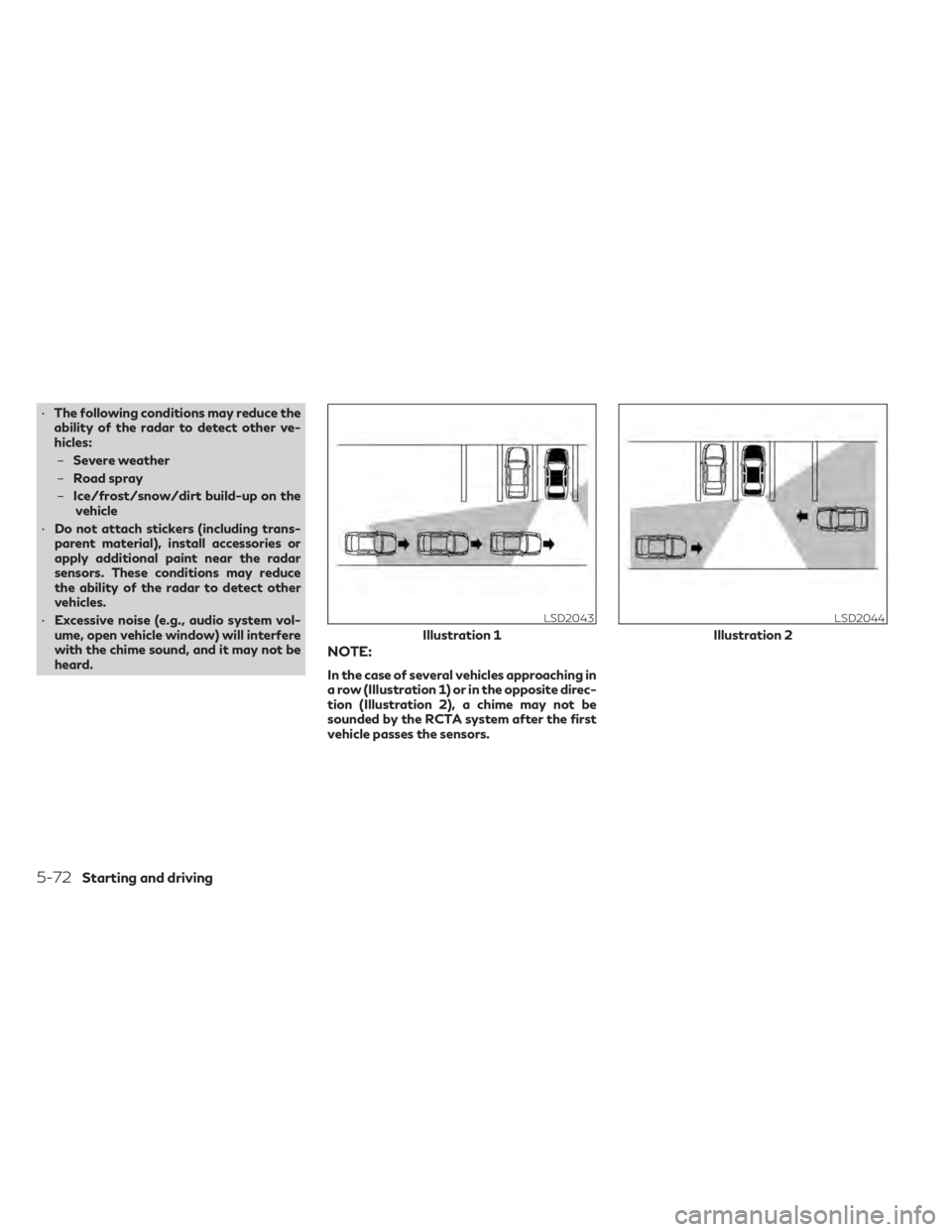
•The following conditions may reduce the
ability of the radar to detect other ve-
hicles:
– Severe weather
– Road spray
– Ice/frost/snow/dirt build-up on the
vehicle
• Do not attach stickers (including trans-
parent material), install accessories or
apply additional paint near the radar
sensors. These conditions may reduce
the ability of the radar to detect other
vehicles.
• Excessive noise (e.g., audio system vol-
ume, open vehicle window) will interfere
with the chime sound, and it may not be
heard.
NOTE:
In the case of several vehicles approaching in
a row (Illustration 1) or in the opposite direc-
tion (Illustration 2), a chime may not be
sounded by the RCTA system after the first
vehicle passes the sensors.
LSD2043
Illustration 1
LSD2044
Illustration 2
5-72Starting and driving
Page 315 of 542

SYSTEM TEMPORARILY
UNAVAILABLEWhen radar blockage is detected, the system
will be deactivated automatically. The “Un-available: Side Radar Obstruction” warning
message will appear in the vehicle informa-
tion display.
The systems are not available until the condi-
tions no longer exist.
The radar sensors may be blocked by tempo-
rary ambient conditions such as splashing
water, mist or fog.
The blocked condition may also be caused by
objects such as ice, frost or dirt obstructing
the radar sensors.
NOTE:
If the BSW system stops working, the RCTA
system will also stop working.
Action to take
When the above conditions no longer exist,
the system will resume automatically.
Malfunction
When the RCTA system malfunctions, it will
turn off automatically. The system malfunc-
tion warning message will appear in the ve-
hicle information display.
NOTE:
If the BSW system stops working, the RCTA
system will also stop working.
LSD3609
Starting and driving5-73
Page 316 of 542

Action to take
Stop the vehicle in a safe location, place the
vehicle in the P (Park) position, turn the en-
gine off and restart the engine. If the mes-
sage continues to appear, have the system
checked. It is recommended that you visit an
INFINITI retailer for this service.
SYSTEM MAINTENANCE
The two radar sensorsO1for the BSW and
RCTA systems are located near the rear
bumper. Always keep the area near the radar
sensors clean.
The radar sensors may be blocked by tempo-
rary ambient conditions such as splashing
water, mist or fog.
The blocked condition may also be caused by
objects such as ice, frost or dirt obstructing
the radar sensors. Check for and remove objects obstructing
the area around the radar sensors.
Do not attach stickers (including transparent
material), install accessories or apply addi-
tional paint near the radar sensors.
Do not strike or damage the area around the
radar sensors. It is recommended that you
visit an INFINITI retailer if the area around
the radar sensors is damaged due to a
collision.
Radio frequency statement
(Type A) (if so equipped)
For USA
FCC: OAYSRR3B
This device complies with part 15 of the FCC
Rules.
Operation is subject to the following two
conditions: (1) This device may not cause
harmful interference, and (2) this device must
accept any interference received, including
interference that may cause undesired
operation.LSD2920
5-74Starting and driving
Page 320 of 542
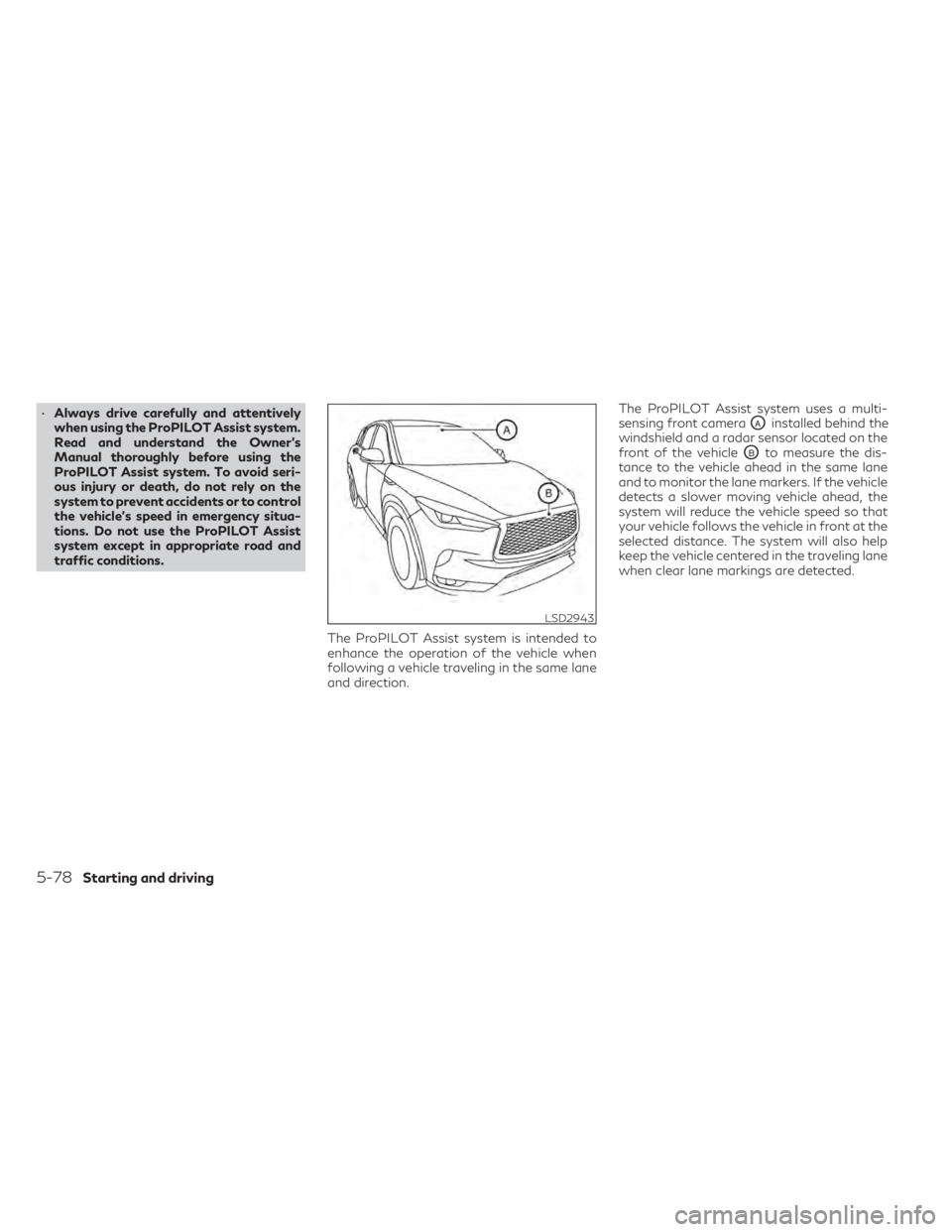
•Always drive carefully and attentively
when using the ProPILOT Assist system.
Read and understand the Owner’s
Manual thoroughly before using the
ProPILOT Assist system. To avoid seri-
ous injury or death, do not rely on the
system to prevent accidents or to control
the vehicle’s speed in emergency situa-
tions. Do not use the ProPILOT Assist
system except in appropriate road and
traffic conditions.
The ProPILOT Assist system is intended to
enhance the operation of the vehicle when
following a vehicle traveling in the same lane
and direction. The ProPILOT Assist system uses a multi-
sensing front cameraOAinstalled behind the
windshield and a radar sensor located on the
front of the vehicle
OBto measure the dis-
tance to the vehicle ahead in the same lane
and to monitor the lane markers. If the vehicle
detects a slower moving vehicle ahead, the
system will reduce the vehicle speed so that
your vehicle follows the vehicle in front at the
selected distance. The system will also help
keep the vehicle centered in the traveling lane
when clear lane markings are detected.
LSD2943
5-78Starting and driving
Page 333 of 542
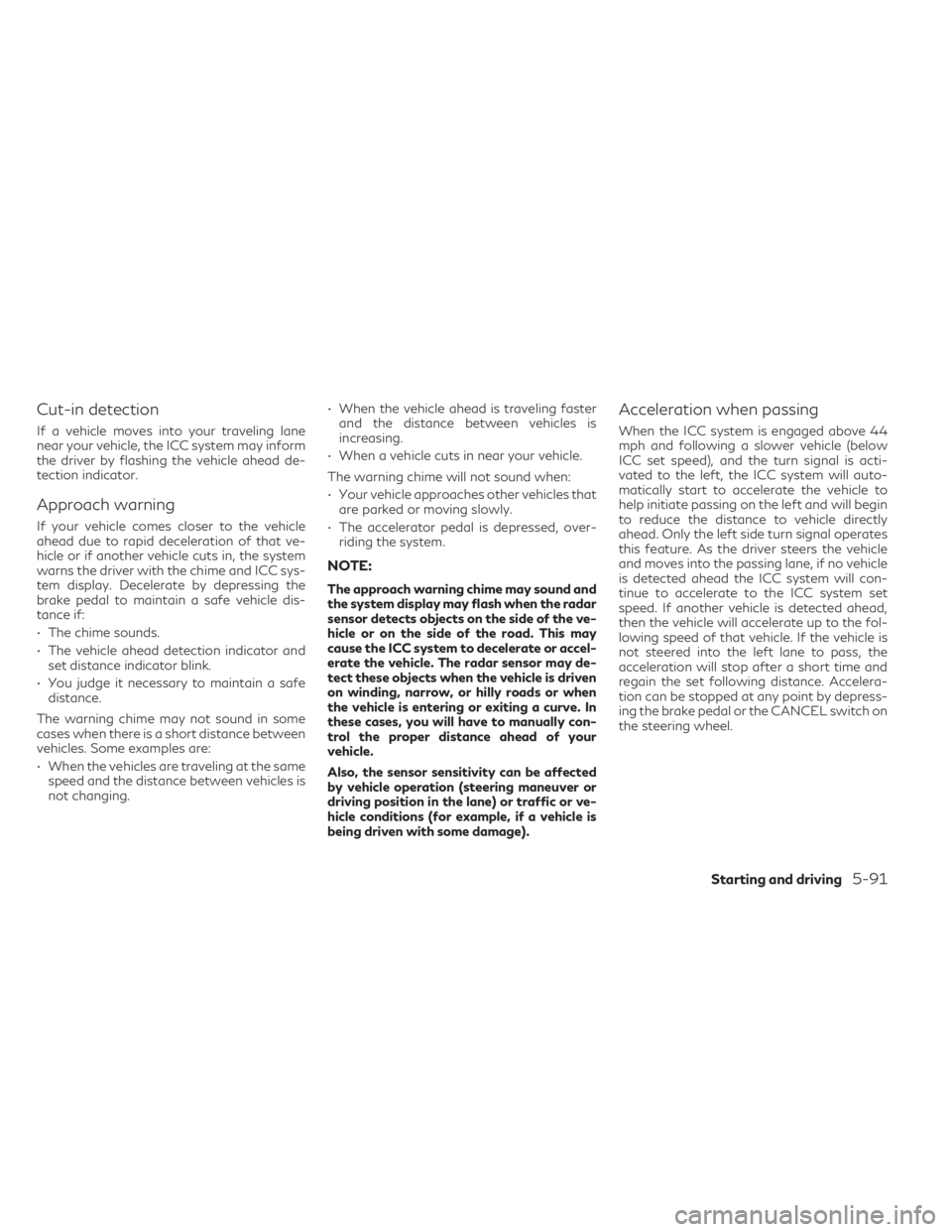
Cut-in detection
If a vehicle moves into your traveling lane
near your vehicle, the ICC system may inform
the driver by flashing the vehicle ahead de-
tection indicator.
Approach warning
If your vehicle comes closer to the vehicle
ahead due to rapid deceleration of that ve-
hicle or if another vehicle cuts in, the system
warns the driver with the chime and ICC sys-
tem display. Decelerate by depressing the
brake pedal to maintain a safe vehicle dis-
tance if:
• The chime sounds.
• The vehicle ahead detection indicator andset distance indicator blink.
• You judge it necessary to maintain a safe distance.
The warning chime may not sound in some
cases when there is a short distance between
vehicles. Some examples are:
• When the vehicles are traveling at the same speed and the distance between vehicles is
not changing. • When the vehicle ahead is traveling faster
and the distance between vehicles is
increasing.
• When a vehicle cuts in near your vehicle.
The warning chime will not sound when:
• Your vehicle approaches other vehicles that are parked or moving slowly.
• The accelerator pedal is depressed, over- riding the system.
NOTE:
The approach warning chime may sound and
the system display may flash when the radar
sensor detects objects on the side of the ve-
hicle or on the side of the road. This may
cause the ICC system to decelerate or accel-
erate the vehicle. The radar sensor may de-
tect these objects when the vehicle is driven
on winding, narrow, or hilly roads or when
the vehicle is entering or exiting a curve. In
these cases, you will have to manually con-
trol the proper distance ahead of your
vehicle.
Also, the sensor sensitivity can be affected
by vehicle operation (steering maneuver or
driving position in the lane) or traffic or ve-
hicle conditions (for example, if a vehicle is
being driven with some damage).
Acceleration when passing
When the ICC system is engaged above 44
mph and following a slower vehicle (below
ICC set speed), and the turn signal is acti-
vated to the left, the ICC system will auto-
matically start to accelerate the vehicle to
help initiate passing on the left and will begin
to reduce the distance to vehicle directly
ahead. Only the left side turn signal operates
this feature. As the driver steers the vehicle
and moves into the passing lane, if no vehicle
is detected ahead the ICC system will con-
tinue to accelerate to the ICC system set
speed. If another vehicle is detected ahead,
then the vehicle will accelerate up to the fol-
lowing speed of that vehicle. If the vehicle is
not steered into the left lane to pass, the
acceleration will stop after a short time and
regain the set following distance. Accelera-
tion can be stopped at any point by depress-
ing the brake pedal or the CANCEL switch on
the steering wheel.
Starting and driving5-91
Page 334 of 542
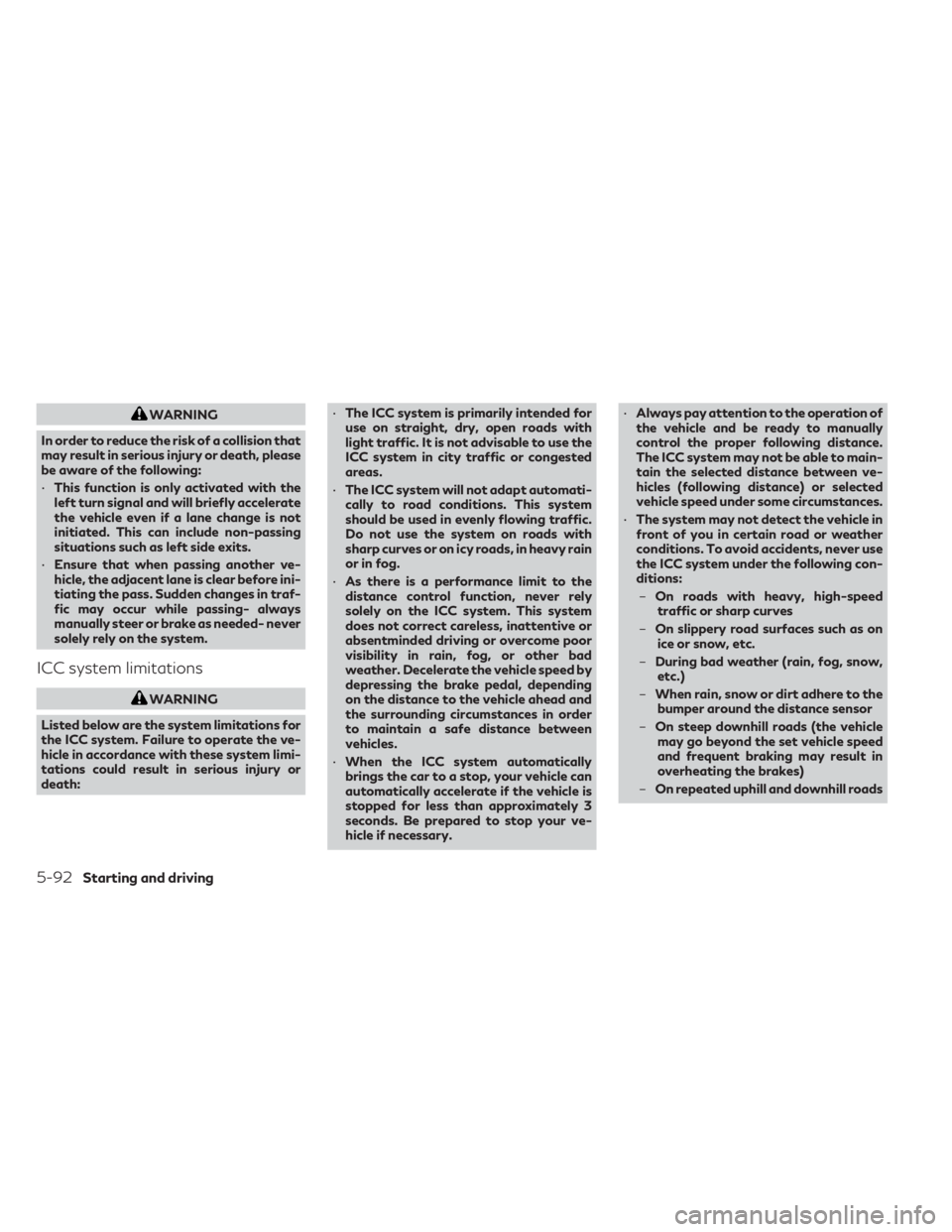
WARNING
In order to reduce the risk of a collision that
may result in serious injury or death, please
be aware of the following:
• This function is only activated with the
left turn signal and will briefly accelerate
the vehicle even if a lane change is not
initiated. This can include non-passing
situations such as left side exits.
• Ensure that when passing another ve-
hicle, the adjacent lane is clear before ini-
tiating the pass. Sudden changes in traf-
fic may occur while passing- always
manually steer or brake as needed- never
solely rely on the system.
ICC system limitations
WARNING
Listed below are the system limitations for
the ICC system. Failure to operate the ve-
hicle in accordance with these system limi-
tations could result in serious injury or
death: •
The ICC system is primarily intended for
use on straight, dry, open roads with
light traffic. It is not advisable to use the
ICC system in city traffic or congested
areas.
• The ICC system will not adapt automati-
cally to road conditions. This system
should be used in evenly flowing traffic.
Do not use the system on roads with
sharp curves or on icy roads, in heavy rain
or in fog.
• As there is a performance limit to the
distance control function, never rely
solely on the ICC system. This system
does not correct careless, inattentive or
absentminded driving or overcome poor
visibility in rain, fog, or other bad
weather. Decelerate the vehicle speed by
depressing the brake pedal, depending
on the distance to the vehicle ahead and
the surrounding circumstances in order
to maintain a safe distance between
vehicles.
• When the ICC system automatically
brings the car to a stop, your vehicle can
automatically accelerate if the vehicle is
stopped for less than approximately 3
seconds. Be prepared to stop your ve-
hicle if necessary. •
Always pay attention to the operation of
the vehicle and be ready to manually
control the proper following distance.
The ICC system may not be able to main-
tain the selected distance between ve-
hicles (following distance) or selected
vehicle speed under some circumstances.
• The system may not detect the vehicle in
front of you in certain road or weather
conditions. To avoid accidents, never use
the ICC system under the following con-
ditions:
– On roads with heavy, high-speed
traffic or sharp curves
– On slippery road surfaces such as on
ice or snow, etc.
– During bad weather (rain, fog, snow,
etc.)
– When rain, snow or dirt adhere to the
bumper around the distance sensor
– On steep downhill roads (the vehicle
may go beyond the set vehicle speed
and frequent braking may result in
overheating the brakes)
– On repeated uphill and downhill roads
5-92Starting and driving
Page 335 of 542

–When traffic conditions make it diffi-
cult to keep a proper distance be-
tween vehicles because of frequent
acceleration or deceleration
– Interference by other radar sources.
• Do not use the ICC system if you are
towing a trailer. The system may not de-
tect a vehicle ahead.
• In some road or traffic conditions, a ve-
hicle or object can unexpectedly come
into the sensor detection zone and cause
automatic braking. Always stay alert
and avoid using the ICC system where
not recommended in this warning
section.
The ICC system will not detect the following
objects:
• Stationary or slow moving vehicles
• Pedestrians or objects in the roadway
• Oncoming vehicles in the same lane
• Motorcycles traveling offset in the travel lane
The following are some conditions in which
the radar sensor cannot properly detect a
vehicle ahead and the system may not oper-
ate properly: • When the sensor detection is reduced (con-
ditions such as rain, snow, fog, dust storms,
sandstorms, and road spray from other
vehicles)
• Driving on a steep downhill slope or roads with sharp curves
• Driving on a bumpy road surface, such as an uneven dirt road
• If dirt, ice, snow or other material is cover- ing the radar sensor area
• A complicated-shaped vehicle such as a car carrier trailer or flatbed truck/trailer is near
the vehicle ahead.
• Interference by other radar sources
• When your vehicle is towing a trailer, etc.
• When excessively heavy baggage is loaded in the rear seat or cargo area of your
vehicle.
The ICC system is designed to automatically
check the radar sensor’s operation within the
limitations of the system.
The detection zone of the radar sensor is
limited. A vehicle ahead must be in the detec-
tion zone for the ICC system to maintain the
selected distance from the vehicle ahead. A
vehicle ahead may move outside of the de-
tection zone due to its position within the
same lane of travel. Motorcycles may not be
detected in the same lane ahead if they are traveling offset from the center line of the
lane. A vehicle that is entering the lane ahead
may not be detected until the vehicle has
completely moved into the lane.
If this occurs, the ICC system may warn you
by blinking the system indicator and sounding
the chime. The driver may have to manually
control the proper distance away from the
vehicle traveling ahead.
The ICC system (with ProPILOT Assist) uses
a multi-sensing front camera. The following
are some conditions in which the camera may
not properly detect a vehicle and detection of
a vehicle ahead may be delayed:
• Poor visibility (conditions such as rain,
snow, fog, dust storms, sandstorms, and
road spray from other vehicles)
• The camera area of the windshield is fogged up or covered with dirt, water
drops, ice, snow, etc.
• Strong light (for example, sunlight or high beams from oncoming vehicles) enters the
front camera
• A sudden change in brightness occurs (for example, when the vehicle enters or exits a
tunnel or shaded area or lightning flashes)
Starting and driving5-93
Page 337 of 542
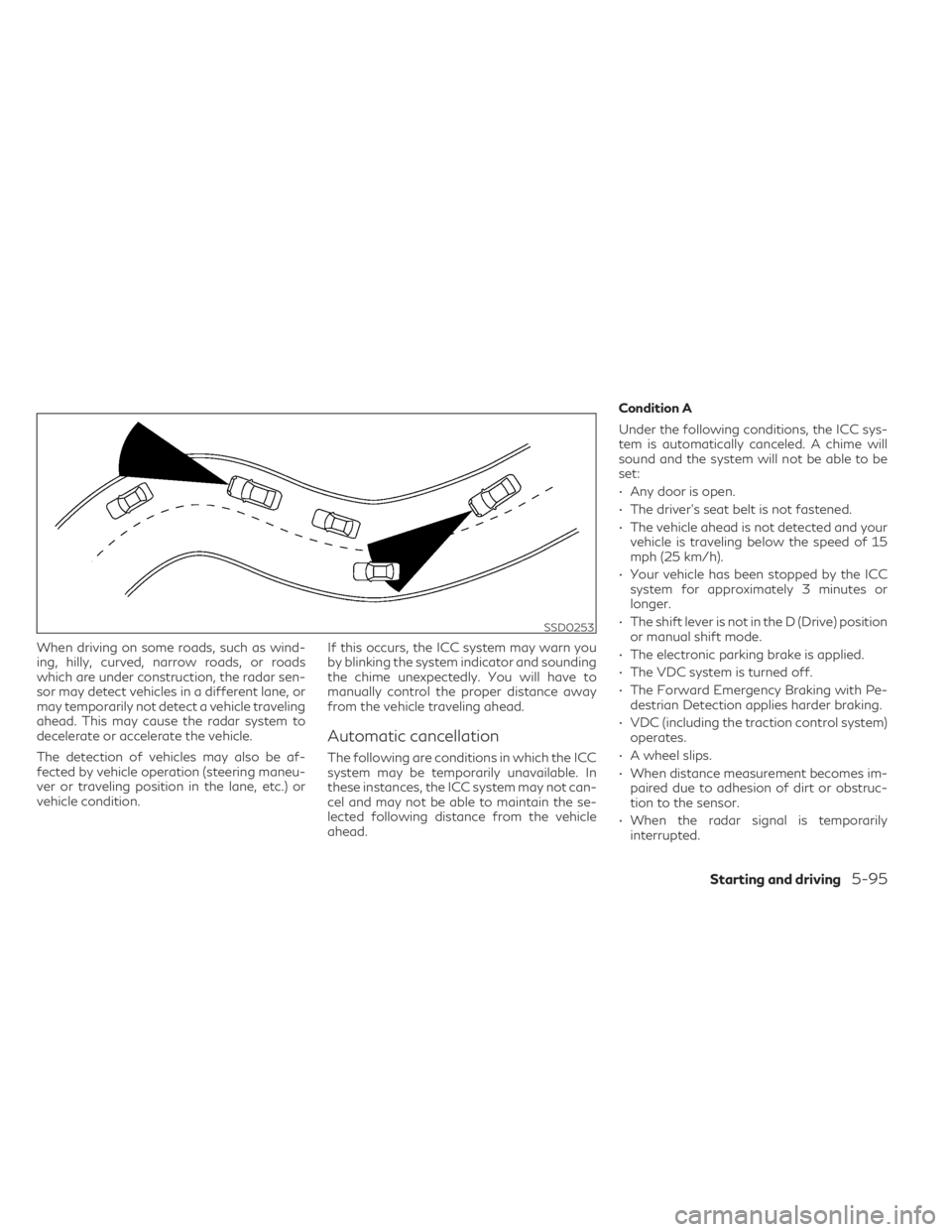
When driving on some roads, such as wind-
ing, hilly, curved, narrow roads, or roads
which are under construction, the radar sen-
sor may detect vehicles in a different lane, or
may temporarily not detect a vehicle traveling
ahead. This may cause the radar system to
decelerate or accelerate the vehicle.
The detection of vehicles may also be af-
fected by vehicle operation (steering maneu-
ver or traveling position in the lane, etc.) or
vehicle condition.If this occurs, the ICC system may warn you
by blinking the system indicator and sounding
the chime unexpectedly. You will have to
manually control the proper distance away
from the vehicle traveling ahead.
Automatic cancellation
The following are conditions in which the ICC
system may be temporarily unavailable. In
these instances, the ICC system may not can-
cel and may not be able to maintain the se-
lected following distance from the vehicle
ahead.Condition A
Under the following conditions, the ICC sys-
tem is automatically canceled. A chime will
sound and the system will not be able to be
set:
• Any door is open.
• The driver’s seat belt is not fastened.
• The vehicle ahead is not detected and your
vehicle is traveling below the speed of 15
mph (25 km/h).
• Your vehicle has been stopped by the ICC system for approximately 3 minutes or
longer.
• The shift lever is not in the D (Drive) position or manual shift mode.
• The electronic parking brake is applied.
• The VDC system is turned off.
• The Forward Emergency Braking with Pe- destrian Detection applies harder braking.
• VDC (including the traction control system) operates.
• A wheel slips.
• When distance measurement becomes im- paired due to adhesion of dirt or obstruc-
tion to the sensor.
• When the radar signal is temporarily interrupted.
SSD0253
Starting and driving5-95